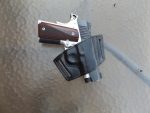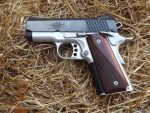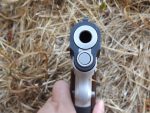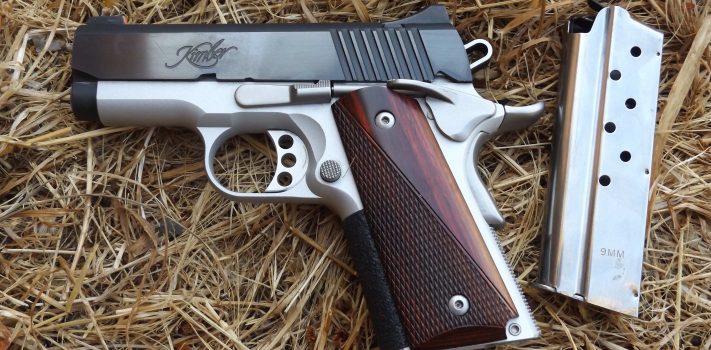Today, we’re taking a close look at the Kimber Ultra Carry II Two-Tone 1911, chambered in 9mm. I’ve always felt that, the 1911 was made for the .45 ACP, so you’ll have to excuse my bias on this – buy I’m learning, so be patient with me. More often than not, I can be “caught” packing a handgun in 9mm these days, so like I said, I’m learning. I think!
I get this question all the time, and there really isn’t any pat answer I can give to folks, but we’ll try once again! “What is your favorite gun?” And, when folks use the term “gun” it can mean any number of different types of “guns” – to include revolvers, semiauto pistols, shotguns – in any number of variations, bolt-action rifles, semiauto rifles, etc. I do have as my one and only firearm, if it ever came down to it, and I could only own one handgun, it would be the good ol’ 1911 in .45 ACP. However, these days, I’m leaning away from it for a number of reasons, more on this, later.
I got my first 1911, a full-sized Government Model, in .45 ACP during a trip to visit family down in Kentucky. For years, I didn’t even realize I had family down there, until my grandmother – who raised me – took me on a train trip to meet those folks, and there were plenty of aunts, uncles and cousins that I never knew I had. Keep in mind, that this was long before the Gun Control Act of 1968, and buying firearms across state lines–without paperwork–wasn’t a problem. It was on my second solo trip down to Kentucky, that one of my cousins took me to a fellow who bought and sold firearms. No FFL paperwork was required at that time. I found a 1911 Government Model in .45 ACP on his table of handguns and did a deal – traded him something for it, along with some cash. My first, but not last 1911, was mine. To this day, I don’t know what happened to that 1911, but its been a lot of years since then.
For those new to firearms, or to the 1911, just a little bit of history on it: It was adopted in 1911 – and was designed by John Moses Browning. He is still a legend, when it comes to many of his gun designs. It wasn’t until 1985 that the 1911 was replaced by the US military, with the Beretta Model 92 (M9 in military form). And, to this day, there is still controversy over the 9mm replacing the .45 ACP. And, also to this day, there are still a few military units who use the 1911 – mostly SpecOps guys. They know a good thing when they see it. So, the 1911 is still the longest-serving handgun in US military history. And, we can’t even begin to count the number of makers turning out 1911s these days – probably a hundred or more to choose from. The number of variations? Who knows, one can’t keep track of this, but its probably safe to say, the 1911 is the most customized handgun in history, bar none!
As I’m rapidly approaching my 70th year on this earth – only a few more years to go. So I have found that my daily  carry needs have changed. I used to love carrying full-sized handguns, especially the 1911 in .45 ACP. I was younger and dumber – but I loved carrying the 1911 police duty and during private security work. There was just something reassuring about that big old .45 caliber bullet, and the 1911 – they were made for each other. I don’t feel the need to carrying full-sized handguns these days, so I carry some sub-compact and even micro-sized handguns concealed, and I ALWAYS carry a spare magazine, no matter what semi-auto handgun I might be carrying.
carry needs have changed. I used to love carrying full-sized handguns, especially the 1911 in .45 ACP. I was younger and dumber – but I loved carrying the 1911 police duty and during private security work. There was just something reassuring about that big old .45 caliber bullet, and the 1911 – they were made for each other. I don’t feel the need to carrying full-sized handguns these days, so I carry some sub-compact and even micro-sized handguns concealed, and I ALWAYS carry a spare magazine, no matter what semi-auto handgun I might be carrying.
We’re told that with today’s modern JHP and similar loads in 9mm, .40 S&W and .45 ACP that they are all just about equal when it comes to man stopping. The FBI is supposedly the lead law enforcement agency, when it comes to such things. Many local and state law enforcement agencies tend to copy whatever guns and ammo the FBI uses, for a number of reasons. I’m okay with that, but my feeble mind refuses to believe that, a 9mm in any configuration is equal to the .45 ACP with JHP or similar bullets when it comes down to stopping a bad gun. I know, I know, the FBI has done scientific research on this, and when it comes down to it, there are only a few points difference between the stopping power of the 9mm, .40 S&W and the .45 ACP, when it comes to putting bad guys down. We also have to keep in mind that, the FBI has been all over the board on this, from the .38 Specail to the .357 Mag, to the 9mm, to the 10mm, to the .40 S&W and the .45 ACP. And they are now packing 9mm handguns, with jacketed hollow point (JHP) ammo.
Kimber 1911s really set the 1911 industry on their heads, when Kimber came out with a “custom” 1911 right from the factory. It had many of the bells and whistles that we 1911 owners wanted, right out of the box, including a match-grade barrel, extended single side combat safety, and a slightly extended mag release lever. It also had an extended “beaver tail” grip safety, and combat hammer, and the ejection port was lowered and flared. They also came with decent combat sights, and it was selling for about the same price that many other factory standard 1911s were selling for, without all these features that Kimber offered.
The Ultra Carry II Two-Tone I tested came in 9mm – I got it in a  trade at my local gun shop some time ago, it just appealed to me, being a compact 1911, and chambered in 9mm. You see, I’m learning to like other calibers in the 1911. Weight of the Ultra Carry II is 25 ounces empty, and the magazine capacity is 8 rounds. (This, while most other similar sized compact 1911s only hold 6 or 7 rounds.) Still, that extra round or two was nice to have. The frame is brushed aluminum, and the slide is carbon steel, highly polished. The barrel is right at 3-inches and that’s as short as you can go in a 1911. The barrel is match-grade, stainless steel and fitted perfectly. Sights are low profile combat, easy to pick-up.
trade at my local gun shop some time ago, it just appealed to me, being a compact 1911, and chambered in 9mm. You see, I’m learning to like other calibers in the 1911. Weight of the Ultra Carry II is 25 ounces empty, and the magazine capacity is 8 rounds. (This, while most other similar sized compact 1911s only hold 6 or 7 rounds.) Still, that extra round or two was nice to have. The frame is brushed aluminum, and the slide is carbon steel, highly polished. The barrel is right at 3-inches and that’s as short as you can go in a 1911. The barrel is match-grade, stainless steel and fitted perfectly. Sights are low profile combat, easy to pick-up.
 I liked the beautiful Rosewood grips that are partially checkered and partially smooth. They make for a fast, no snag draw from under clothing. The trigger is match-grade, aluminum, three-hole, and the trigger pull was right at 4 pounds. The hammer is a speed, combat-style hammer, and the main spring housing is checkered plastic. The front strap was left smooth, and I added a strip of friction tape to it – like I do that to most 1911s for a better hold. The sights are all-black and I added a touch of orange finger nail polish to it, so it was faster for my aged eyes to pick up. The gun was used, but looked “as-new” when I got it. However I swapped out the recoil spring for a brand-new one – just in case the one in the gun was getting old.
I liked the beautiful Rosewood grips that are partially checkered and partially smooth. They make for a fast, no snag draw from under clothing. The trigger is match-grade, aluminum, three-hole, and the trigger pull was right at 4 pounds. The hammer is a speed, combat-style hammer, and the main spring housing is checkered plastic. The front strap was left smooth, and I added a strip of friction tape to it – like I do that to most 1911s for a better hold. The sights are all-black and I added a touch of orange finger nail polish to it, so it was faster for my aged eyes to pick up. The gun was used, but looked “as-new” when I got it. However I swapped out the recoil spring for a brand-new one – just in case the one in the gun was getting old.
This gun was, once again, a personal purchase. I carried it daily for several months, in between carrying other handguns for articles. I used a Safariland belt slide holster, about as small as I care to go with a holster, that still holds the gun snug against my body. I also carried a spare 8-rd magazines on my off-side. The gun concealed quite well, over the summer months, with only a button down shirt covering it. I never fully button my button down shirts – they are used un-tucked as a covering garment.
I did my accuracy testing at 25-yards, because I knew this little compact 1911 had real potential. Using a rolled-up sleeping bag as a rest, over the hood of my wife’s SUV, I had great results. From the nice folks at Black Hills Ammunition I had a great selection of 9mm to run through this little Kimber. From their HoneyBadger line, I had their 100-gr all-copper +P round as well as their 125-gr all-copper subsonic load. Both of these use the all copper bullets that are fluted. However, they perform like JHP when it comes to doing damage, and a little deeper penetration. I also had Black Hills 115-gr JHP +P, 124-gr JHP +P, 115-gr FMJ, 115-gr EXP (Extra Power) hollow point, and their 115-gr Barnes TAC-XP +P load. In well over 500 rounds of shooting – some just killing rocks and punching paper and other targets of opportunity, there was not a single malfunction, of any type.
Best accuracy was from the Black Hills 124-gr JHP +P load – and it came in right at 3.25-inches if I stayed on my game. I usually shoot several groups with the same load, to make sure I’m getting the best accuracy I can. Some days, I’m off my game, and I’ll return in a day or two, for the accuracy testing part of testing a firearm. The 125-gr HoneyBadger subsonic load came in hot on the heels of the 124-gr JHP +P load, and everything else was still under 4-inches – keep in mind, this is a 3-inch barrel gun, and I was shooting it at 25-yards, over a rest. Nothing to complain about here, except…
I just couldn’t shake the feeling that, although this Kimber is considered a “compact” 1911, it is still too big for a 9mm compact – in my humble opinion. There are several similar compact 1911s on the market today, that are actually reduced in sized, compared to the Kimber, and they are chambered in 9mm. When it comes down to it, I guess I’m saying the Kimber is “too big” for the 9mm round. Still, its not a bad choice, but I’ll go with one of the other smaller compact 1911s in 9mm. The Kimber is meant for the .45 ACP if you ask me – just my two cents worth. However, you can’t go wrong if you select this little 1911 – even if it is “only” in 9mm – for self-defense.
Today, I’m leaning more and more, towards either a Glock 19 or the newer Glock 19X – both in 9mm, as my one and only handgun – if it came down to that. II’m really falling for the Glock 19X if that were the only handgun I could own, heaven forbid!











Last May (2019) I cut my ring finger to the bone, cutting the artery and nerve with broken glass. I self treated (former SF Medic) and the finger is slowly gaining feeling. In June, I fell and ran a punji stick through the space between the pinky and ring finger on the same hand into the center of the palm (almost 3 inches). That required a trip to the ER ($1500 for cleaning and stitches). The dirt was down inside the palm and I couldn’t reach it. Point is, those 2 fingers are numb right now and it’s causing issues with the 45 shooting. So I’ve converted to the 9mm (Springfield 1911 10 shot and XD9 15 rnds). At 65 yrs old this may have been a side benefit of the injuries. The hand doesn’t throb using a 9mm. I may keep this XD9 as the new carry gun.
Switch hands. I did at age 60, due to permanent hand injury. For me, it was actually switching to my dominant eye……discovered after the hand switch. Lefties rule!
So, the short version of this article is:
The history of the 1911,
1911s in 9mm suck
Buy glock.
Yay!
Pat, I really enjoy your reviews. This old coot is also getting on in years. I HAD a ‘favorite gun’. Arthritis was a gun-changer. I think some gals share the difficulty of operating larger caliber handguns. Reviews of small caliber handguns might be helpful.
Speaking just for myself, I have wide hands but short fingers. I don’t have trouble with the larger calibers if the handgun is a single stack model, because I can grip it more tightly than a double stack. My favorite handgun to shoot is my full size 1911. However, it’s not my favorite handgun to EDC concealed. For that, because of my small size, I need something much smaller.That Kimber sure is pretty, though! And, Pat, I’m just as young as you 😉
Been reading your articles for some time now and really enjoy what you have written about, especially when if concerns the 1911. I’ll never see 70 again and been have using a .45 1911 off and on for many yrs, full size and commander. But a yr or so ago, I happened across a SF Armory range officer compact in a 9mm. It’s a delight to carry and fun to shoot, although it has been back to the factory once already. Then last summer, I tried out a Bersa thunder plus, it’s a little smaller in size, twice ( almost ) the number of rounds, but I don’t like or care for the Cerakoted finish. So the jury is still out on that one. Keep up the good work.
For those of us 1911 guys, what about the Browning Black Label .380? I own one. Very concealable, and accurate. My son, a police officer, liked it so much, he bought one as well. Kind of expensive though.
Just thought I’d throw that info out there.
Thanks Pat for all your reviews.
Dear Pat: Again I must stress the Taurus G2C (12 rounds of 9mm or 10 of .40). Cost and reliability are always issues for the “common American”. That is why I keep asking you to test and promote this excellent CCW pistol from Taurus. You can get an upgrade kit from Lakeline LLC for about $50.00. This kit includes a stainless striker guide, recoil spring and rod guide. Also Palmetto State Armory is a great source for a quality AR-10 or AR-15 for a most reasonable price. The USA is headed into some rough times ahead, I am most sorry to say! Hang on to Jesus real tight, as the USA is headed for a very bumpy ride for it’s law abiding citizens! May the “light of Jesus” shine on the USA. Psalm 144.
Pat,
Given the opportunity, compare this Kimber to the Para Ordnance Expert Carry. Aside from the hand grip being full size and chambered in .45, pretty much everything else is the same (in my opinion).
Also if you are going to lean towards the Glock 19X, you should take a gander at the Glock 45 as well.
Great article Pat
This article is targeted to concealed carry. The one thing to note here is that the same Kimber frame size can be had in 45acp. I have one. It’s an Ultra CDP (Compact Defense Pistol). It may have a few less rounds per magazine but my personal belief is a 9mm is no substitute for a 45acp power wise. Yes there has been new technology, mostly in bullet design that has increased the potential of the 9mm. However, there’s an old engine saying “there ain’t no substitute for cubic inches”. The same is true for cartridges. Whatever can be done to a small caliber can be done to a larger caliber with greater results. That said, I’m a 10mm guy since the Colt Delta in 1989. It is only slightly less in “cubic inches” than a 45 but has a lot more horsepower. A friend carries a Glock 20 but I prefer the Springfield XDM, lots of firepower (16r) and more energy than 45acp. Granted these are not easily concealed guns but here in bear country I don’t think they will notice. As a testament to the 10mm I have never seen a compact 10. I believe this is due to physics. There just isn’t a spring yet that short to handle the slide recoil.
From the Hornady reloading manual:
9mm / 124gr HP / max velocity: 364 foot pounds muzzle energy
10mm / 180gr HP / max velocity: 624 foot pounds muzzle energy
45acp / 230gr HP / max velocity: 413 foot pounds muzzle energy.
Then again there is the purpose:
In an urban environment the desire would be to stop a single threat, not multiple non threats beyond. 9mm or 45acp would be the ticket.
In the boonies the desire is to stop a charging bear, or a moose more likely. Backround would not be a factor. High capacity 10mm (or 12ga) would be the ticket.
I would say that 2 great authorities on the 9mm vs 45 ACP stopping power argument ( and I own multiple pistols/revolvers in 9mm/.40 S&W/.45 ACP/ .38 spl) are Ken Hackathorn and Larry Vickers. Ken used to be Mr. 45 and has now, due to arthritis and such in his hands, switched to 1911 style pistols in 9mm. Larry Vickers is a former delta spec ops guy and if he says 9mm is now an adequate self defense option I would not argue much. The man has been there, done that.
At the end of the day shot placement remains the most critical factor in stopping your opponent with a handgun. If you run Kens Wizard drill ( watch it on YouTube ) you will see what he says regarding your handgun choice and how effective whatever you have will be in a lethal firearm shootout. Pass that with even a .380 and as he says you are good to go.